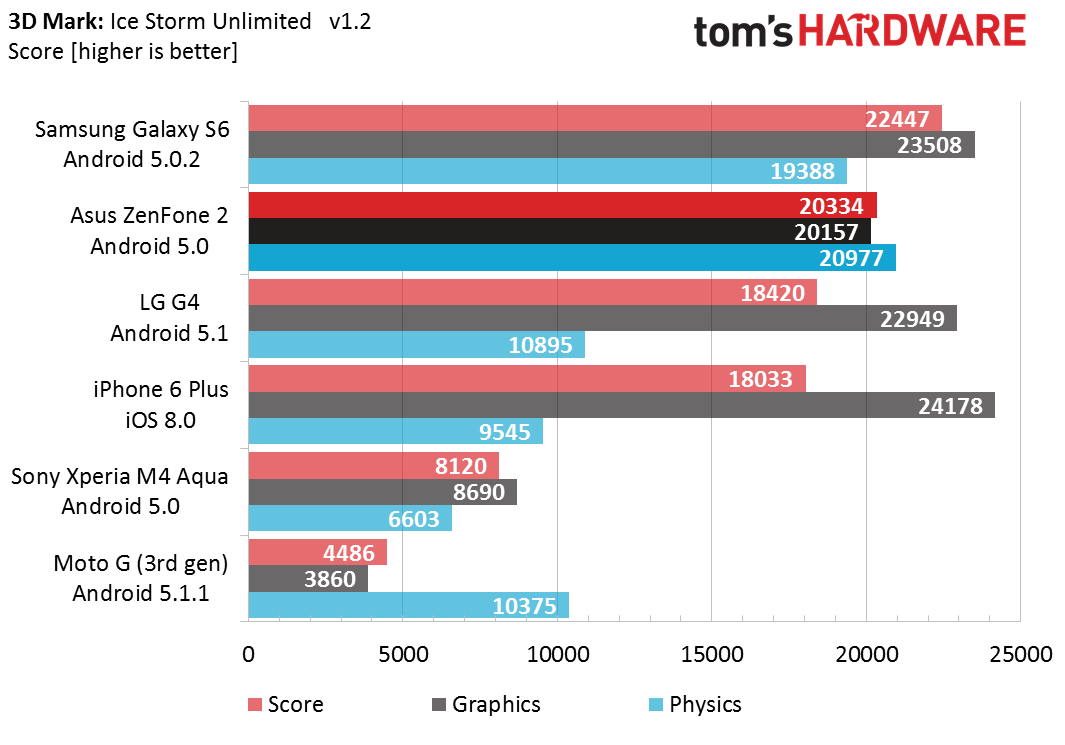Asus ZenFone 2 Review
Asus’ 5.5-inch smartphone comes with an Intel processor and 4GB of RAM. Will its PC-like approach to creating smartphones leave you in a Zen-like state?
Why you can trust Tom's Hardware
GPU And Gaming Performance
Mobile GPU performance is becoming increasingly important as people begin to see their phones and tablets as portable gaming machines. This section explores GPU performance with several synthetic and real-world game engine tests. To learn more about how these benchmarks work, what versions we use, or our testing methodology, please read our article about how we test mobile device GPU performance.
The PowerVR GX6450 GPU in the iPhone 6 Plus is the direct descendent of the G6430 GPU used in the ZenFone 2 (also used in the previous generation iPhone 5s). These GPUs have the same ALU performance, processing 256 FP32 FLOPs/clock. The ZenFone 2 runs its GPU at either 457MHz or 533MHz under load, and while we do not know the exact peak GPU frequency for the iPhone, it does lie within this range. This means we should see similar performance in pixel shader bound workloads. Where the GX6450 gains an advantage, is in front of and behind the unified shader cores, improving vertex processing and pixel fill rate, respectively.
In 3DMark, the ZenFone 2 keeps pace with the flagship phones. The iPhone 6 Plus leads the pack in the first graphics test that focuses on vertex processing, clearly benefitting from its front-end architectural tweaks. The ZenFone 2 is 19% slower but only 12% slower than the speedy Galaxy S6.
Qualcomm’s Adreno GPUs perform well in ALU-bound workloads, so it’s no surprise to see the Adreno 418 in the LG G4 post the highest frame rate in the second graphics test that focuses on pixel processing. The ZenFone 2 is 18% slower than the G4 and 15% slower than the iPhone 6 Plus.
The 3DMark Physics test focuses on CPU performance and uses a data structure that requires random memory accesses. As we touched on in the AndEBench memory latency test, the memory controllers in the iPhone’s A8 SoC and G4’s Snapdragon 808 SoC are optimized for serial data access patterns, which penalizes them heavily in this test despite their fast CPUs. Intel’s Atom SoC embraces random memory patterns, propelling the ZenFone 2 to the front of the pack, beating even the S6. This is one of the reasons it performs so well with real-world apps.
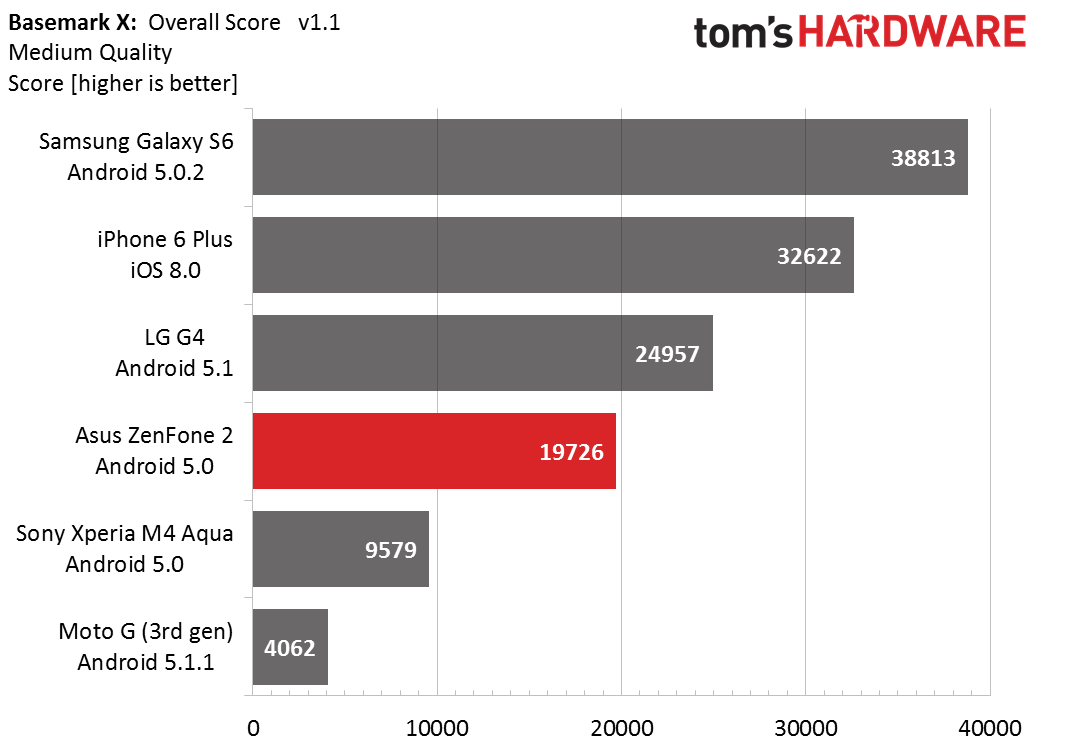
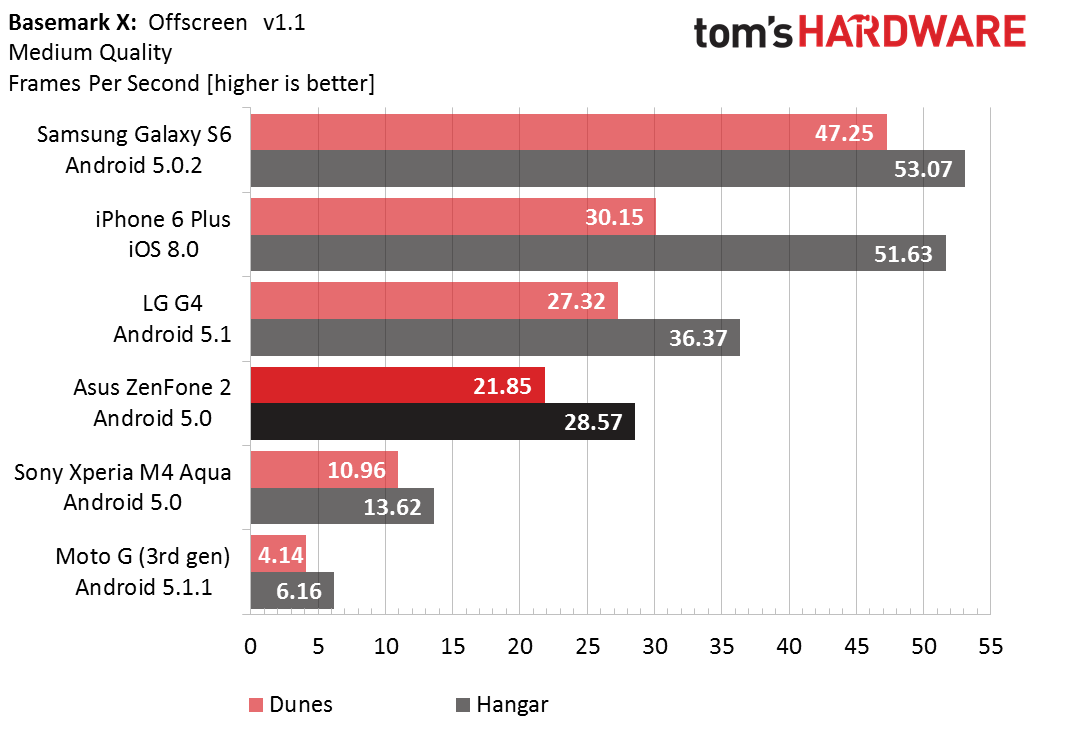
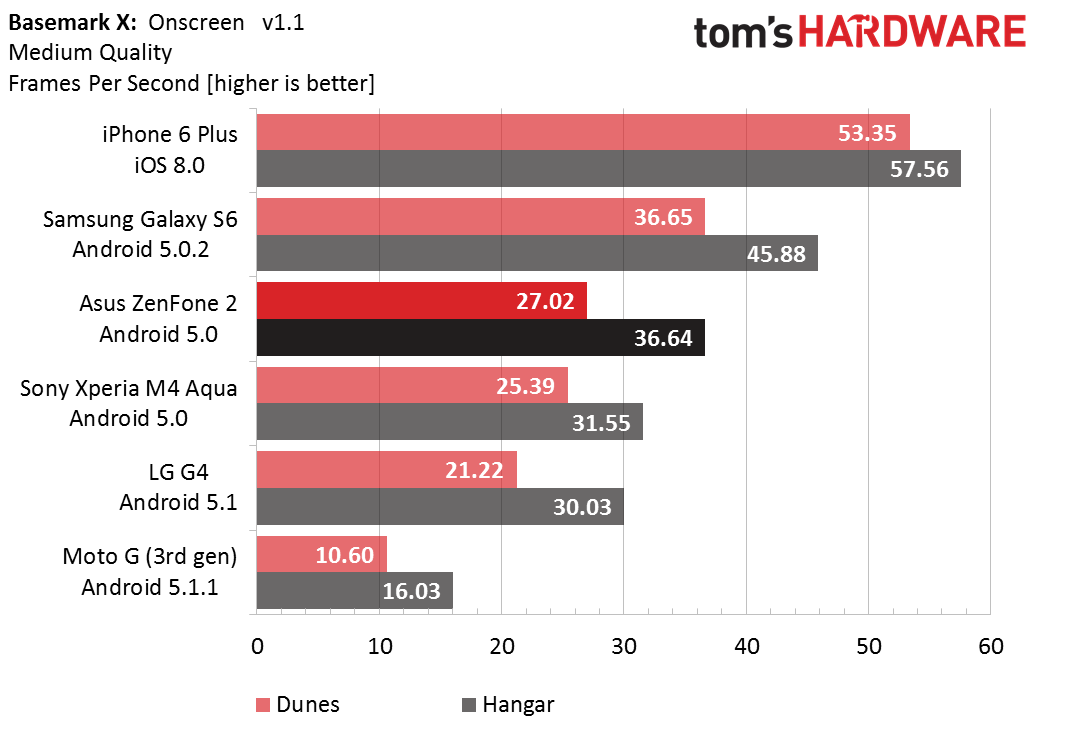
Basemark X is a very demanding benchmark, heavily stressing the entire graphics pipeline, especially vertex processing. At the medium quality setting, the ZenFone 2 is only 21% slower than the LG G4, but it cannot keep up with the other flagship devices, coming in 40% slower than the iPhone 6 Plus. It does manage to outperform the G4 in the onscreen test, where the latter device gets bogged down by its QHD resolution.
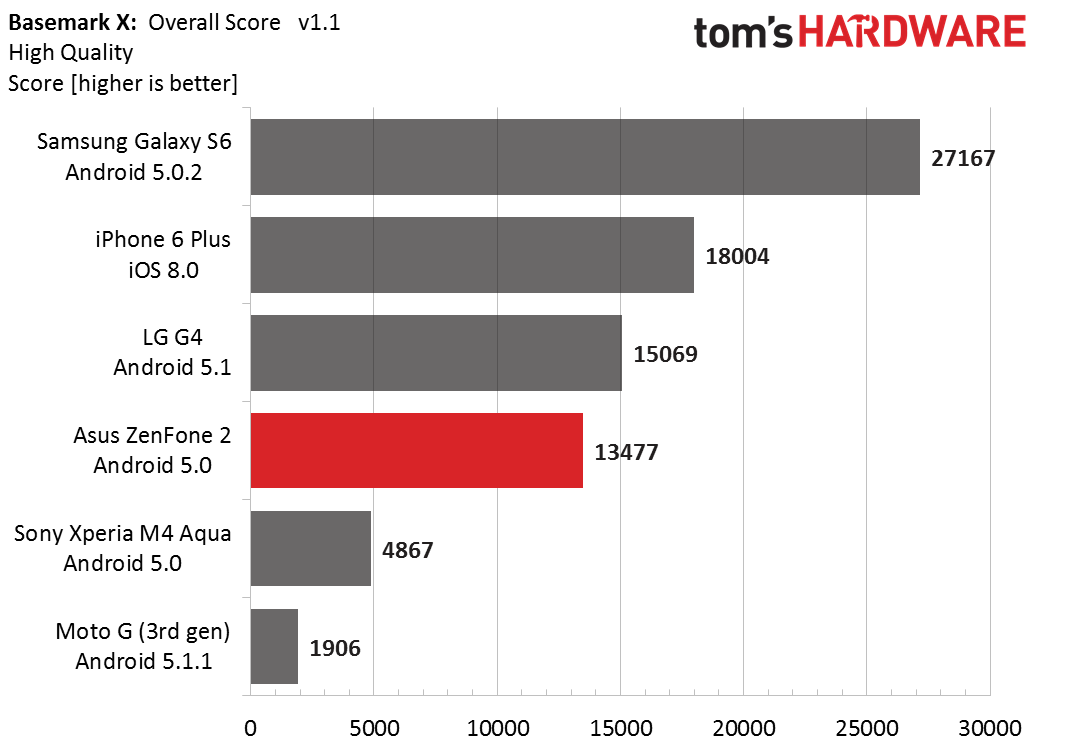
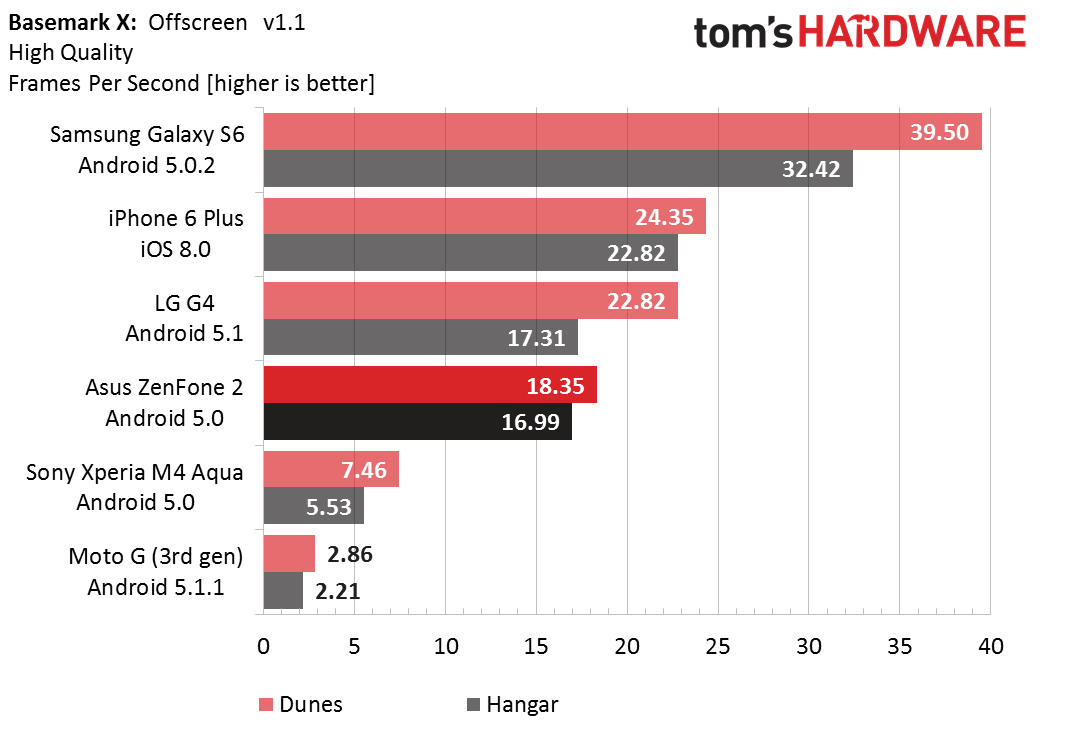
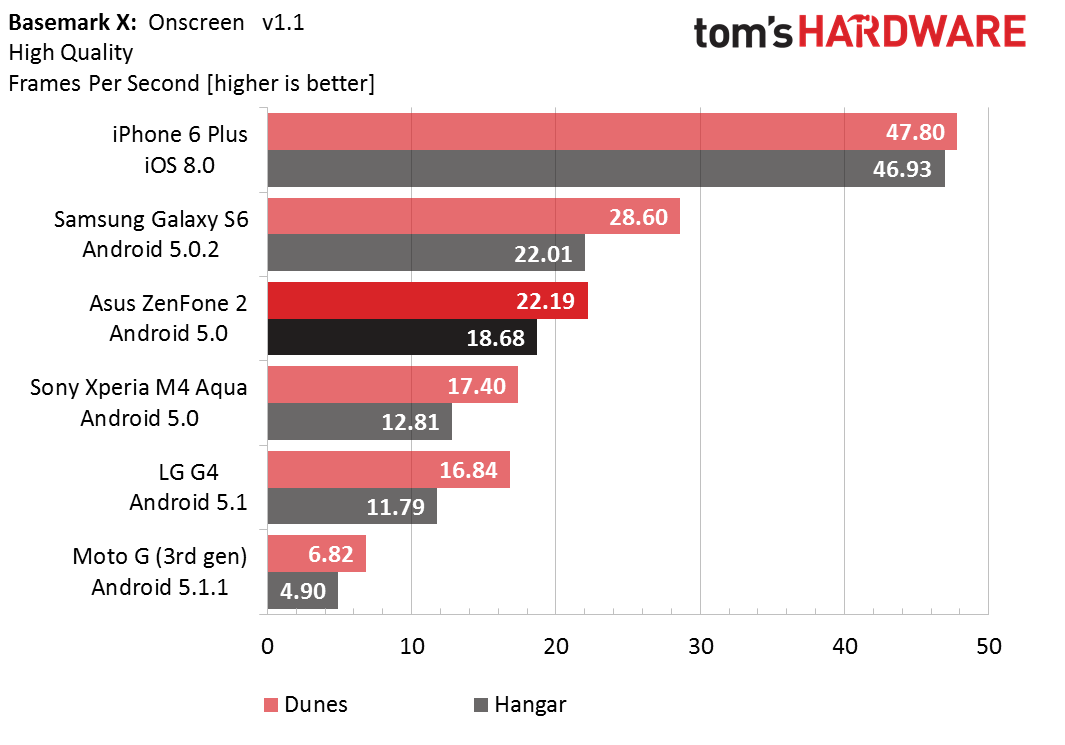
The order does not change at the high quality setting, although the gap between the ZenFone 2 and the flagship phones closes a bit; it’s only 11% behind the G4 and 25% behind the iPhone 6 Plus. Fed by bountiful memory bandwidth, the Mali-T760MP8 in the Galaxy S6 is a vertex processing machine, propelling it to the top of the chart.
Get Tom's Hardware's best news and in-depth reviews, straight to your inbox.
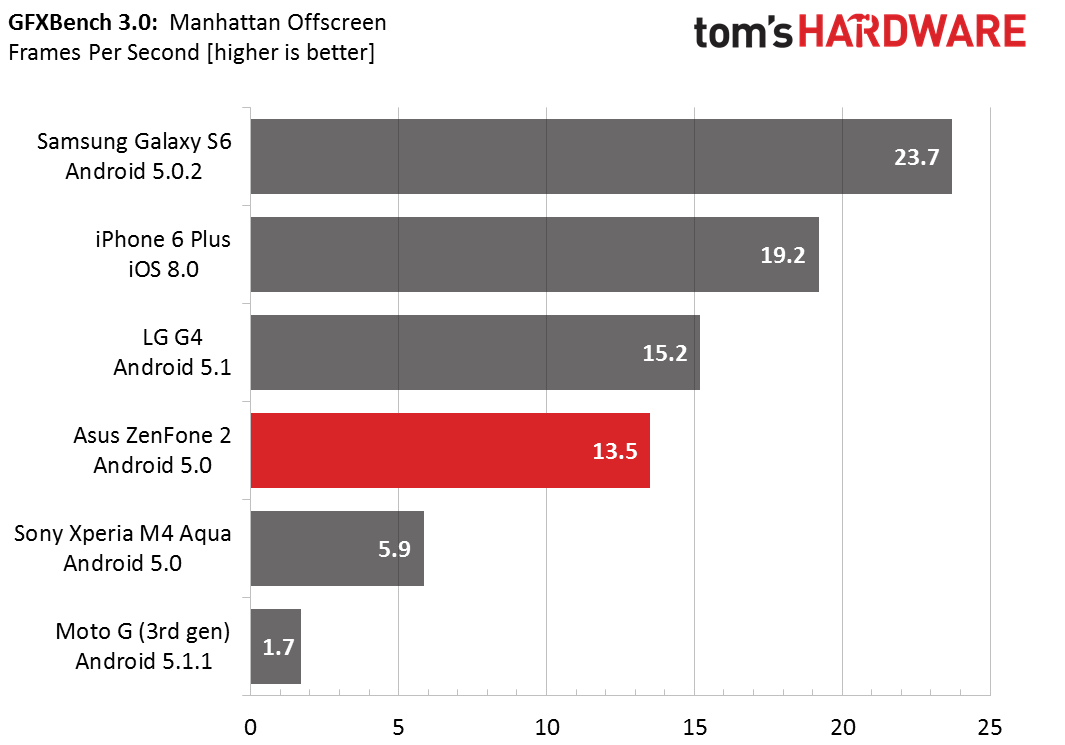
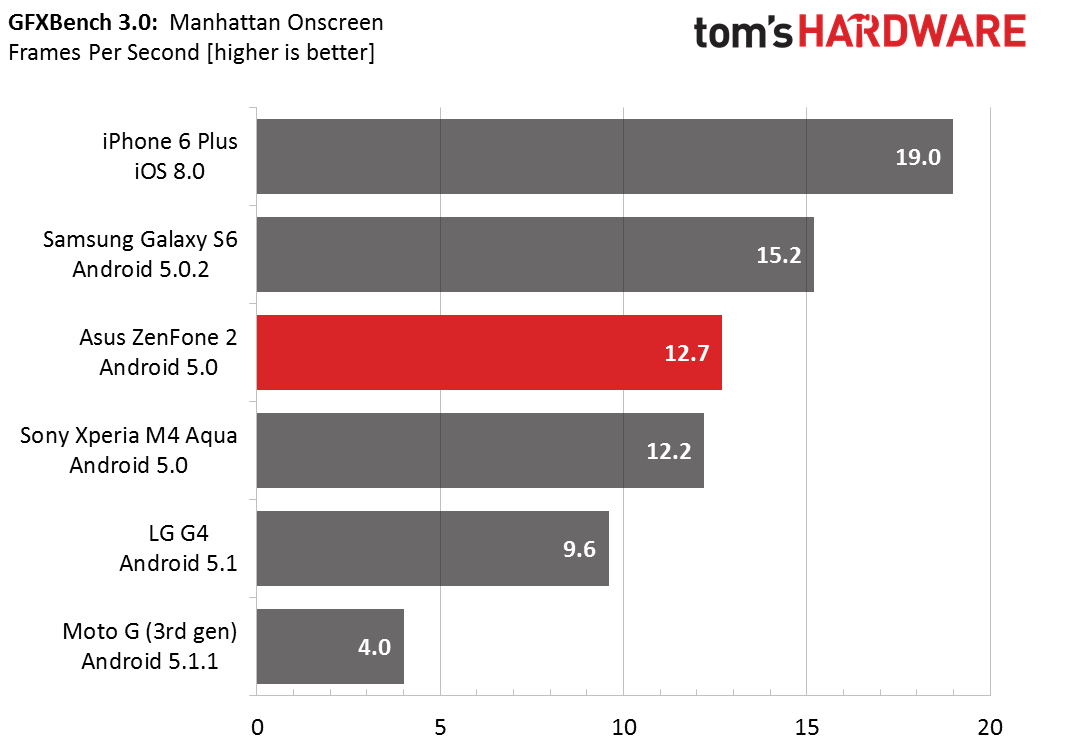
The OpenGL ES 3.0 based Manhattan test makes heavy use of pixel shaders and other post-processing effects. As we’ve seen in the previous tests, the ZenFone 2 has no trouble outperforming the Adreno 306 and 405 found in the Moto G (3rd gen) and Xperia M4 Aqua. Although it’s not shown in our chart, the ZenFone 2 also performs better than Snapdragon 801 powered devices such as the Galaxy S5 and OnePlus One using the Adreno 330 GPU. For reference, the ZenFone 2 is 30% slower than the iPhone 6 Plus when running Manhattan.
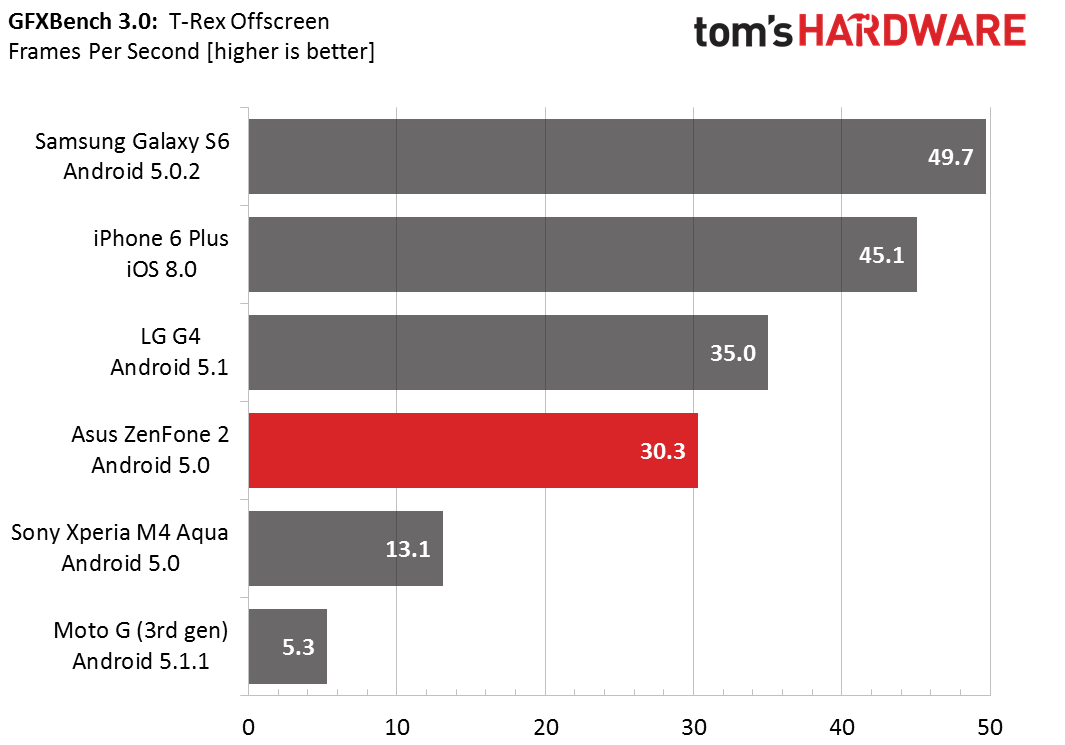
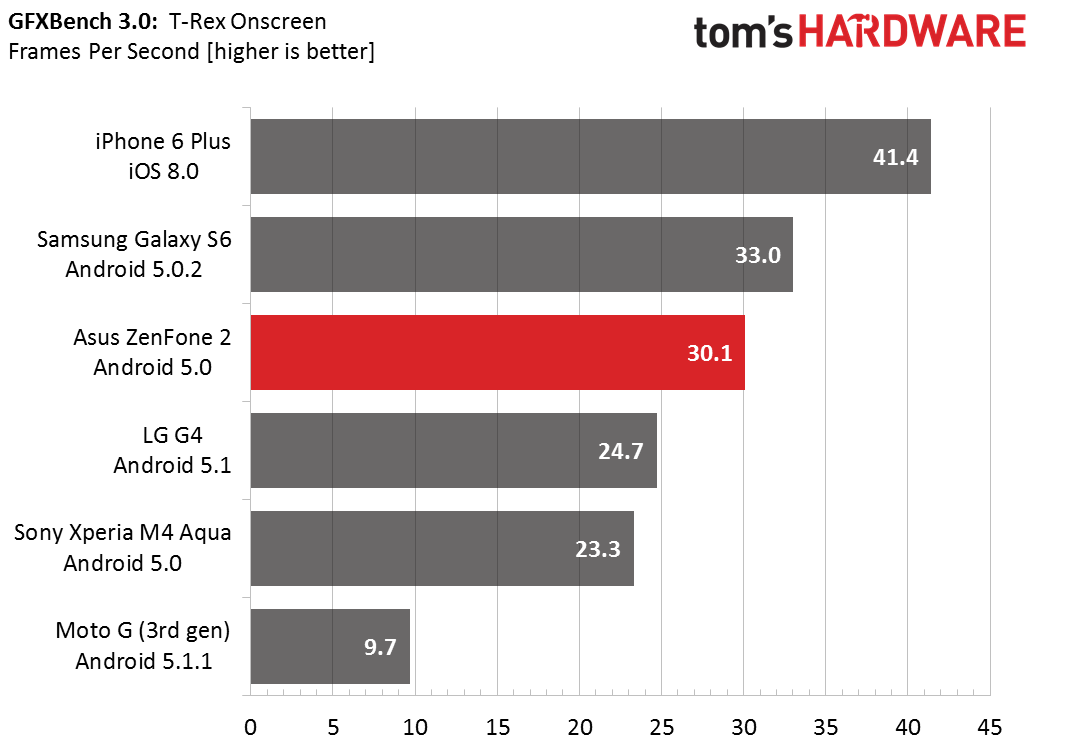
T-Rex results mirror those from the Manhattan test, including the ~30% deficit to the iPhone 6 Plus.
We mentioned previously that the PowerVR G6430 GPU in the ZenFone 2 and the GX6450 GPU in the iPhone 6 Plus should have the same ALU performance, an observation confirmed by the GFXBench 3 ALU test. It also comes very close to matching the ALU performance of the Galaxy S6. Currently, the Adreno GPUs have the advantage in FLOPs/clock, which is why the LG G4 tops the chart in this test.
The Mali-T760MP8 GPU in the Galaxy S6, along with the two PowerVR GPUs, can all process up to eight texels per clock. However, the ZenFone 2 falls behind the iPhone 6 Plus in the Fill test by 14%. It’s likely that the iPhone’s GX6450 has larger texture caches as one of its back-end improvements. In addition to some architectural differences, the Mali GPU in the S6 runs at 700MHz versus the ZenFone 2’s 533MHz, increasing its advantage.
With its last generation GPU, the ZenFone 2 falls behind the latest flagship devices. Compared to the iPhone 6 Plus, the Asus phone is roughly 30% slower (15% to 40% based on our tests). However, it does perform better than other phones in the same price range, in some cases considerably better. Even more impressive, the less expensive version of the ZenFone 2 that comes with the Atom Z3560 SoC uses the same PowerVR G6430 GPU tested here, giving you gaming performance similar to the iPhone 5s for only $200.
Throughout this section, we kept comparing the ZenFone 2 to more expensive, flagship devices. This may seem unfair, but it’s actually a compliment. The midrange ZenFone 2 just performs more like a low-end flagship than the lower-cost phone that it is.
Current page: GPU And Gaming Performance
Prev Page CPU And System Performance Next Page Battery Life And Thermal Throttling-
wtfxxxgp I like the look. I love the price. Seems like a gem of a phone if good value is more important to you than the latest and greatest tech. I wonder if it'll be available here in South Africa...Reply -
MasterMace 2 things that ding the phone before it even started: locked battery, 1080p screen. The LG G4 and Galaxy S6 both have 1440p screens. The LG G4 has a removable battery.Reply -
edwd2 Reply2 things that ding the phone before it even started: locked battery, 1080p screen. The LG G4 and Galaxy S6 both have 1440p screens. The LG G4 has a removable battery.
Yeah, but the G4 and S6 also cost a whole lot more. Not to mention that the G4's A418 has trouble powering that 1440p res while the G6430 is just fine with a 1080p screen.
And what does LG have to offer in the $200 price range? The LG G-Stylo runs a crappy SD410 and 720p display. -
g-unit1111 I wish we'd embrace the concept of dual SIMs and unlocked phones more here in the States. This is a very nice phone for the price and more carriers should be able to use it, right now it seems like only AT&T and Verizon can use it, leaving T-Mobile and Sprint out of it.Reply -
PC98226 Great review. I was looking for your comments re: this device's ability to maintain wireless connectivity. I have been using the 4GB version of this phone for several months now. While I found it to have a VERY snappy speed, I experienced some quirks re: it connectivity. I would frequently have to check why the phone stalled trying to open up a web site only to realize that it had switched the connection from my WiFi to my wireless printer. This happened so frequently that it slowed me down re: productivity. I suspected there was some type of software glitch that needed to some attention. So, until that happens, I have returned to using my Moto X (2014). During your testing of this device, did you see or experience anything like the above?Reply -
MRCPU I own one of these, and I really like it. Asus has been very good about pushing fairly regular software updates, much faster than any carrier. For a time, it seemed like updates were hitting like clockwork about every 2 weeks.Reply
However, the one downside to this phone is the *massive* amount of bloat. The author touches on it a bit, but did not convey how much pure crap resides on this phone stock.
However, there are many fixes available to that problem. A quick google for debloating scripts will get you headed in the right direction.
My only other gripe is that mp3-based notification tones don't seem to consistently stop if you like touch the screen, or acknowledge the notification, you can't flip the phone over to silence it like on the Galaxy series. But these are minor nits.
I get a full day of usage out of my battery, the quickcharge is nice, and for 300 bucks, the extra features of the other phones aren't appealing enough.
I recommend this phone to anybody. -
PC98226 Reply16526515 said:"....However, the one downside to this phone is the *massive* amount of bloat. The author touches on it a bit, but did not convey how much pure crap resides on this phone stock."
Yes, I totally agree re: the massive amount of crapware pre-installed on this device. I tried to either uninstall or disable all that I could (nearly 33 apps in all) before I installed the apps I wanted to use. Now, these apps no longer auto-update so that is a help.
-
GoZFast I owned this phone from newegg since late May and I have to say that its the best phone I have ever had over LG, Samsung, iPhone, Blackberry etc The kernel is 64 bit but not the OS. Asus are working on a completely x86_64 Intel OS based on Android/Linux source code. Some apps are not x86 compatible yet but when they are, they run much more efficient than ARM. Its price of 299$ for the top 4Gb RAM model is too good for what it offers and if you even want more, you can join ZenTalk beta forum. With beta firmware, the phone is faster and battery lasts longer, never had an issue with beta firmware so far. This is also the coldest phone I have had, much colder than G3 and G2. Anything over 1080p in a 5'' device is pointless and will just consume more battery, create more heat and put a high load on the GPU. What also amazed me is that you can run 128Gb SDcards EVEN if the specs says 64Gb (Lexar 633x) The 18W 9V2A charger is faster than Samsung's 9V1.67A adaptive charger. Here is my newegg review, basically, the Atom CPU beats the SD810 and S6 in single threaded performance (Floating-point and Integer), it only loses in multithread (Hence, higher Antutu score) because its rivaling 8 cores so imaging doubling this in a future phone! I also doubt that playstore apps will take advantage of 8 cores like Anututu and hence, their higher score doesn't mean that 4 core or less apps will be faster. Intel can easily add more cores with 14nm but other are already 8 cores with 14nm and it will be very hard to increase performance with more than 8 cores. Intel Core M with Intel GPU in tablets is 3.5W while the Atom is 2.2W. If Intel can find a way to integrate it into smartphone, it will be a heck of a phone considering that it gets ~3000pts in PassMark similar to Intel Core i5-3317U or an AMD A10-5757M.Reply
Pros: Intel 64bit 3D 22nm Quad 2.33Ghz
4GB Ram, did I underscore its speed?
This outperforms all current cellphones (yes, faster than snapdragon 810) and have lots of headroom for improvement on intel architecture with more instruction sets for programming. We will probably see this device quad boot; android:windows:linux:mac os x
Lots of potential.
9v 18w charger! Higher than 12w ipad lol
Cons: PowerVR G6430, same architecture as iphone 6+ but this intel extracts more gpu power vs dual-core 1.4ghz apple.
Wish it had intel graphics which is up to 4x more powerfull than Adreno 430, highest current mobile gpu. Intel graphics would also throw more compatibility and instruction sets into the table.
14nm and 3200mah maybe?
Camera could be better (4k?) but not a fan of photography, it does what it says.
Other Thoughts: For more battery life, put screen into reading mode and dim it as the default setting is very bright. Also, there is option to powersave in settings. You can also remove unnecessary apps, use system app remover for system apps (Not needed with Beta firmware) Getting better battery than my old g3.
p.s: With beta firmware, you can disable/uninstall any app you want, even system apps without root. Root will break OTA and live beta updates. Many of these apps are actually useful though. Also, I found that Nova launcher decreased RAM usage by 80Mb and its snappier (Doesn't need root) -
fyend Asus rivals Samsung with the amount of uninstallable crapware they preload on their phones. If you're planning to root, that's fine you can remove it all, but if not you're stuck with a lot of junk.Reply
